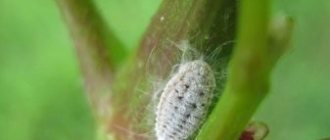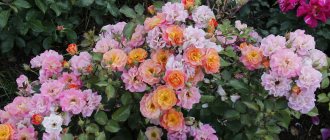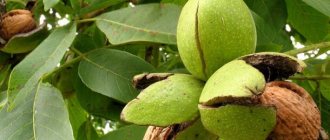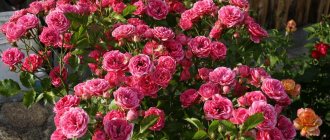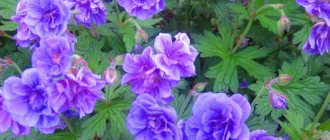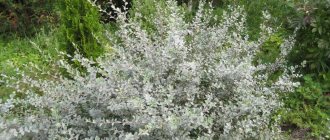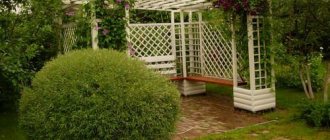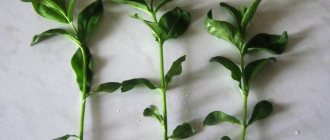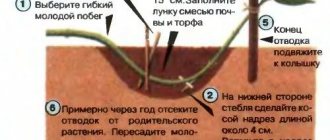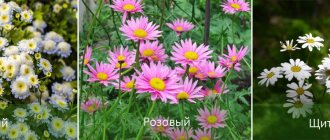Lawson Elwoodi cypress - planting
There are 7 species of cypress trees, which in turn have many varieties and forms. Some of them:
- Pea-bearing;
- Lawson;
- Nutkansky (yellow);
- Mourning;
- Tuevidny;
- Blunt;
- Formosan.
The most varieties are of the Lawson variety, among them the Elwoodi variety.
The most varieties are of the Lawson variety, among them the Elwoodi variety. Lawson's cypress is found naturally in North America, with a maximum height of 60 meters and a width of 1.8 meters. In Russia, cultivation is possible in the middle zone; in such conditions, the tree reaches only 2 meters.
The bark of the tree is dark, red-brown in color. The tips of the shoots are drooping; it is possible to form a crown with a drooping top. The needles are bluish-green, the cones are small and also have a bluish tint. The Elwoodi variety tree can grow up to 3 meters, and the needles have a blue tint.
For growing Lawson cypress in the southern regions, fertile loamy soil is suitable, in the northern regions - loose sandy loam. In the second case, the roots will quickly defrost and move away from the frost. The plant loves acidic soil, the parameters of which are within the pH range of 4.5-5.5.
The location can be chosen arbitrarily. Elwoodi cypress retains the color and characteristics of its needles both in sunny places and in the shade. The tree will continue to grow actively when changing locations. The only place where cypress will not grow is in lowlands with stagnant cold air.
Cypress trees can easily be transplanted into open ground.
Cypress quickly adapts after transplanting into open ground. Transplantation activities are carried out in late spring early summer. The root collar should not be buried deep when planting. After planting, the tree is watered abundantly and shaded from open sunlight. Until rooting occurs, the needles are sprayed. Although the plant loves a large amount of moisture, it reacts negatively to stagnant water. But the top layer of soil should never be dry.
The planting pit is prepared in the fall. Its size should be slightly larger than the root system of the tree. It contains:
- peat;
- leaf soil;
- turf land;
- mineral and organic fertilizers;
- broken brick;
- crushed stone.
To keep moisture in the soil longer, it is mulched.
Elwoodi indoors
Miniature cypress trees take root well at home. Comfortable living environment - diffused light, sufficient air and soil humidity, timely feeding and transplanting. It is better to keep a pot with a thorny inhabitant in the shade. The bark may be damaged from bright sunlight and burns will appear on the crown.
The best place for cypress in summer is the northern and eastern window sills indoors or a shaded loggia. In winter, diffused lighting will be appropriate. A plant can also be damaged by a lack of light: its crown color will change, its branches will begin to stretch. It should be borne in mind that varieties with colored needles need more light than those with typical bluish-green needles.
Specimens for indoor floriculture
Home cypress does not tolerate heat and dry air, especially in winter, when heating radiators are actively working. The salvation will be to place the pot away from the radiators. The optimal temperature for keeping indoor conifers in winter is 15°C. An insulated loggia would be a good option for wintering.
Reproduction of Elwoodi cypress
A gardener, to his taste and based on his capabilities, can propagate cypress trees in three well-known ways - layering, seeds or cuttings.
Prepared cuttings - cut from shoots up to 12 centimeters long - take root in the open ground with the organization of timely watering and maintaining the same temperature.
A small greenhouse is created by placing plastic bottles over the cuttings. Care continues until new needles appear, usually until spring. Then the bottles are removed and the cuttings are transplanted to the desired location.
Using cypress layering, Elwoodi can be propagated by bending the lower shoots towards the ground. The shoot is fixed in this position, the fracture site located in the ground is treated with a growth stimulator. After a year, the cuttings are cut off and transplanted to the desired location. In this case, additional insulation using a greenhouse or plastic bottles is not required.
Description of the variety
Elwoodi cypress was common in ancient Rome, where it was used for funeral rites. The plant can actually be kept indoors, but most often it is found as an outdoor shrub. It was brought from North America, but East Asia is considered another homeland.
Ephedra is capable of reaching a height of 3.5 m, but only at the age of 10 years and when cultivated in unprotected soil. As for the indoor plant, it grows to a maximum of 35 cm. Over the course of a year, the bush grows no more than 5 cm. Unlike other cypress trees, Elwoodi stands out for its cone-shaped crown, reaching a diameter of 1 m. The plant can be purchased in small containers , both in stores and in nurseries.

As the conifer grows, it needs to change the container to a container of larger volume.
Thanks to its excellent winter hardiness, the plant has become quite popular in many regions of Russia. Plus, the shrub feels quite comfortable both at sub-zero temperatures and in hot weather.
Varieties of Lawson Elwoodi cypress:
- Empire. It grows up to 1.5 m in height. The shoots develop perpendicular to the surface of the earth and are located quite densely. The needles are characterized by a green color with a golden tint;
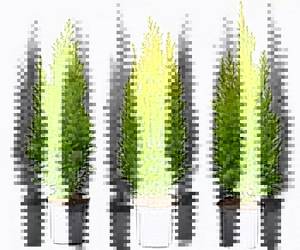
- Gold. A fairly large variety with a height of up to 2.5 m. The branches are covered with dense needles of a light green color with bright yellow tips. A similar coloring is obtained when planting a plant in an open area. In shaded areas the color will be simply green;
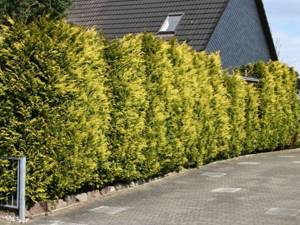
- Pilar. The plant has a sparser crown than the Empire variety. The needles are bluish-green with a blue tint. The height of the plant is 2.2 m;
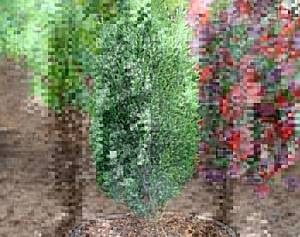
- Snow White. A low-growing specimen that grows only up to 1 m. This cypress tree has the appearance of a lush bush with bluish-blue needles and grayish edges.
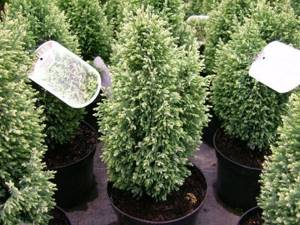
Cypress care and possible problems
You will only have to care for the cypress while it is young, then it will decorate your garden all year round
Caring for Elwoodi cypress is easy. Young, immature plants need shelter for the winter. Adults are more frost-resistant. Snow, spruce branches or peat are used for shelter. Young trees are covered with a fabric cover.
As for fertilizers, they are applied only at a young age. Over time, the root system becomes powerful and branched and is able to provide the tree with the required amount of useful elements. Young individuals begin to be fed in early spring, when the snow melts. Complex or mineral fertilizers are used. It is important not to overdo it, as this is fraught with illness. Fertilizers are applied once every two weeks, the last one being applied in mid-summer.
There should be no lack of moisture in the soil and air. You can spray the tree once a week, often resorting to watering with a hose. For watering, it is enough to add 1 bucket of water directly under the stem; if the season is hot, then watering is carried out more often. Mature plants tolerate drought better, but young plants will have to be carefully monitored. It is important that in the first years of the cypress tree’s life the peat lump does not dry out.
Cypress can be easily propagated using 3 methods:
- seeds;
- cuttings;
- layering.
For seeds to germinate well, they need cold stratification. Propagation by cuttings is carried out in spring or summer. Cuttings are cut from the side shoots; any light substrate is suitable for them. If constant high humidity is maintained, rooting will occur quickly.
Layers are propagated in early summer; for this purpose, young branches are bent to the ground, fixed and watered as often as possible. By autumn, rooting should occur, then the shoot can be cut off and transplanted into a box. The cypress tree is transplanted to a permanent place in the fall.
When the frosts pass, the cypress tree will need to be pruned. First of all, dry branches are removed. You can also start shaping the crown; overgrown branches make the tree less neat and undecorative. All sections are processed to eliminate the risk of fungus development. To ensure that the tree has the desired shape, it is tied with a wire structure in the fall.
It is worth remembering that, like all other plants, Lawson cypress can get sick. And the most common diseases are the following:
- root rot;
- drying of branches and bark;
- Schutte brown;
- scale insects;
- spider mite
To get rid of pests, use a solution of actara, actellik or karbofos. Spraying is carried out until the parasites completely disappear.
Is it possible to plant in open ground?
Lawson is incredibly picky about soil acidity, which should not go beyond 4 to 5.5 pH. For example, sandy soils are suitable. Any limestone or clay in the composition will negatively affect the growth and appearance of the plant. The sun on the site is vital only for cypress trees with yellow foliage, otherwise they will lose their specific color and become untidy green.
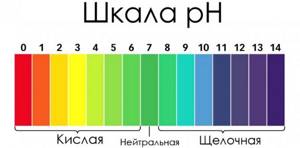
Otherwise, Lawson easily tolerates partial shade and short daylight hours. But the exotic tree is not afraid of frosts; an adult plant easily tolerates frosts down to -20°C, does not get sick and does not even slow down its growth. Only young, immature seedlings need to be covered with spruce branches or special non-woven materials. Moreover, it is important, as soon as the earth begins to warm up, to remove the protection, otherwise there is a high risk that the rotted earth will become a favorable environment for rot and fungal infections, and the young root system will not withstand this.
Important! In regions with warm climates, it is recommended to plant the plant in loamy soil that has been previously fertilized. In colder parts of the country, cypress trees should be planted in loose sandy soil, which will help keep the roots from freezing.
Difficulties that arise when growing cypress in open ground include the plant’s high need for regular and very extensive watering. And on days of drought, it is also important to sprinkle, that is, spray the crown. When planting in a garden bed, it is mandatory to mulch and loosen the tree trunk circle, since the evergreen crown constantly evaporates moisture.
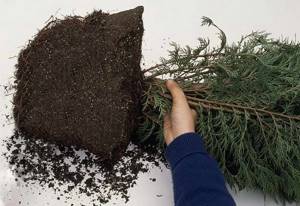
The powerful root system quickly depletes the nearby soil and requires generous feeding with organic and mineral fertilizers, at least once a month. Every spring you will have to undergo sanitary pruning with the removal of dry branches and wilted shoots. A classic garden varnish may be useful for treating fresh wounds. But if you are not afraid of the amount of trouble ahead, you can safely plant a Lawson cypress and wait for the tree, rich in color and aroma, to grow.
We advise you to read how to distinguish thuja from cypress.
Cypress transplant
Lat. Chamaecýparis
Complete care for Elwoodi cypress includes the possibility of replanting. Most often it is required in cases where the plant reaches a large size and does not fit into the pot.
If you need to replant a cypress tree, you should take into account that the bushes have long vertical roots. This complicates the process, since during transplantation the roots can be damaged, which often leads to the death of the plant.
Before transplanting, it is necessary to prepare a new container or hole. A drainage layer (broken brick, sand or expanded clay) will be placed at the bottom. The recommended drainage thickness is 20 cm.
Transplant stages:
- The plant is dug up from all sides
- The bush is removed together with the soil-root ball
- The soil mixture is poured onto the drainage layer (up to half the pot’s capacity)
- The plant is placed in a container, covered with the required amount of soil mixture, and watered
The greatest difficulty is the extraction process. It is not recommended to grab the plant and pull it - this leads to damage. It is best to remove the bush behind the root ball, where the risk of damage is lower.
Transplanting a cypress tree is a complex procedure that requires great care and compliance with a number of rules.
Characteristics of cypress
According to the world classification, this coniferous plant belongs to the Cypress family, the Cypress genus and the Lawson's Cypress species. It also has several varieties: Snow White (with a white tint of foliage), Gold (with a golden tint), Empire (with a bluish tint) and others. The homeland of the Elwoodi species is eastern Asia and the northern part of America.
Compared to other members of the family, this cypress tree grows slowly: the annual growth of its conical crown is 3-5 cm. In 10 years, it can reach only 1.5 m in height. Mature specimens rise 2-3.5 m. The width ranges from 60-120 cm.
The bark is red-brown. Not very long, tightly closed branches are directed upward, and the ends of the shoots are slightly inclined. Young trees have needle-shaped needles. Then they acquire scales and become rhombic, with a blunt tip. The needles exude a strong and pleasant aroma. During flowering (spring), bluish cones 1-1.2 cm in size appear, in each of which no more than 2 seeds ripen. The root system is superficial, with a lot of fine roots.
Lighting and temperature
For full growth, it is necessary to maintain suitable climatic conditions for cypress. Maintaining an optimal climate when growing a plant at home is extremely difficult. The bushes are not picky about light, but if the room is very dark, the plant loses its shape.
When there is little light, the needles turn green, but the natural color is preserved only if there is enough light. Therefore, in winter, it is recommended to store the plant on the windowsill at a temperature of 10-15 degrees. In summer, it should be placed in the shade, sprayed regularly, and, if possible, taken out into the air.
Climatic conditions, temperature and lighting for cypress play an important role, influencing the condition of the plant.
How to care for cypress
After planting or transplanting, the conifer in question does not require particularly careful care.
Watering
First of all, attention should be paid to watering - the ground should be moderately moist. In summer, the bush should receive more moisture than in winter. Lawson Elwoodi prefers well-drained soils and watering with a frequency of about 2 times a month when grown outdoors and in dry weather.
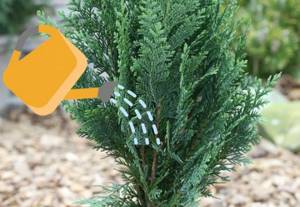
If the plant is located indoors, watering will depend on the ambient temperature and the volume of the pot. It should be taken into account that the soil in containers needs to be moistened more often than outside. If the soil has dried to a depth of two centimeters, then it’s time to water it. If there is no mulch layer, after each watering it is necessary to weed and loosen the tree trunk circle to a depth of 20 cm.
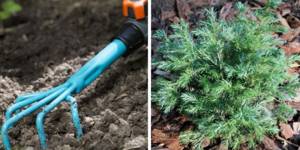
Feeding
To make the cypress tree feel as comfortable as possible, it is recommended to add small amounts of compost and liquid fertilizers to the soil. Without the latter, it is unlikely that good decorative effect will be achieved. Young plants especially require additional nutrition. Starting in spring, fertilizers are applied every 2 weeks. The last feeding is carried out in mid-summer. Experienced summer residents and gardeners often use Kemira for conifers.
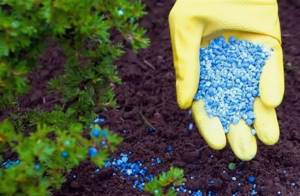
Fertilizers should be applied in strictly recommended doses to avoid damage to the roots.
Trimming
Shrub care also involves periodic pruning. During spring, trim the edges of stems that have been damaged by frost. Old and dried branches must also be removed. Along with sanitary pruning, formative pruning is also carried out. During the latter, the crown shape is simply maintained in the form of a pyramid or cone.
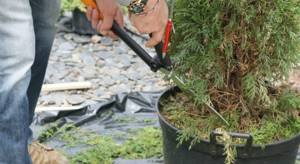
It is important to remember that during one pruning, a maximum of a third of the green part of the shoot should be removed. In the fall, after the end of active growth, 1/3 of this year's growth is cut off, maintaining the same crown shape. In general, crown formation begins a year after planting the shrub in the ground.
Diseases and pests
The plant in question is quite resistant to diseases and harmful insects. However, spider mites and scale insects are sometimes found on conifers. If the needles begin to turn yellow and fly off, this indicates the appearance of a spider mite. In the case of scale insects, the bush begins to dry out and the needles fall off. The tick should be combated with the help of acaricidal drugs, for example, Apollo, Neoron; Nuprid will help you cope with the scale insect.

Among the diseases of Lawson Elwoodi one can note root rot. Most often it occurs when water stagnates in the soil. When planting a plant, drainage is placed in the hole for preventive purposes. If the bush is still affected, it is dug up, the damaged part of the root system is cut off, treated with a fungicide and planted in another place.
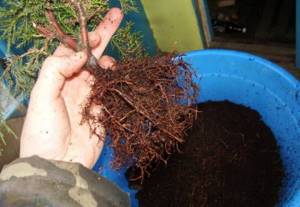
Growing outdoors
In general, caring for cypress trees in the open field does not differ significantly from growing them at home. The plant needs systematic watering (once every 7 days). When planting several bushes, a distance of at least 1 meter should be maintained.
On hot days, it is recommended to spray the pine needles. The soil is periodically fed with complex fertilizers. Feeding is stopped in the second half of summer. Pruning is done in the fall. It is necessary to remove 1/3 of the annual increase.
Caring for open ground is a complex process that includes watering, fertilizing, and pruning.
Home care
Elwoodi cypress, grown as a houseplant, needs certain conditions.
The tree is placed near a window or on a balcony so that it is well lit by the sun. Windows facing east are ideal; diffused bright light is what a cypress tree needs.
On the shady side, varieties with green and blue needles do well, while golden and light-colored specimens need bright lighting. On the south side there is a danger that the needles will burn in the bright sun. You can correct the situation by shading the glass with regular tulle or tinting film.
Advice. In order for the crown of a young plant to develop evenly, it is necessary to rotate the bush around its axis from time to time, exposing different sides to the light.
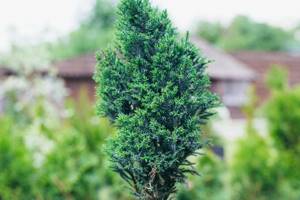
Comfortable air temperature for a perennial in summer is +20… +22 degrees, in winter not lower than 0.
Comfortable air temperature for a perennial: in summer +20… +22 degrees, in winter not lower than 0 (specimens planted in open ground are insulated). The scourge of a cypress tree living in a city apartment is dry air in winter and too high a temperature. An ephedra suffering from heat and dryness loses its needles and may die. If it is not possible to place the plant on a glassed-in balcony or in a cool greenhouse, its crown is regularly sprayed with cool water. Place a bowl of water near the pot with the plant to increase air humidity.
Advice. Ephedra reacts positively to small ice cubes placed on the soil in a pot. Ice not only moistens the soil, but also evaporates moisture and cools the air.
Watering and spraying
Elwoodi cypress is watered so as to prevent the soil from drying out. The roots of the plant are superficial, so the conifer does not tolerate drought well. The limited amount of soil in the pot makes the situation worse. In summer, the plant is watered 2-3 times a week. During the cool winter (the plant is placed on a balcony or in a greenhouse), moisten the soil once every 10 days.
Important! The soil should not be allowed to become waterlogged. This will lead to root rot disease in the root system. Water that has flowed into the pan after watering must be drained.
Water for watering the cypress tree is taken cool (but not icy!), rain or tap water, which has stood for at least 2 days.
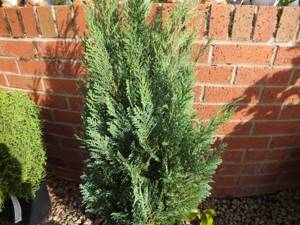
Elwoodi cypress is watered so as to prevent the soil from drying out.
Spray the plant daily in summer, and as needed in winter. Comfortable air humidity for cypress is about 68–70%. The cool wintering of the perennial eliminates spraying. It is sometimes useful to add a few drops of Epin or Zircon to the water.
Feeding
Elwoodi cypress is fed during the active growing season: from April to September. They use only mineral fertilizers, buying a special mixture for coniferous plants (“Buyskie fertilizers”, “Pokon”, “Fertika”). To feed a plant placed in a container, the dosage of fertilizer recommended on the package is halved. The frequency of feeding is once a month.
Important! The nutrient solution is watered on the ephedra only after watering with clean water. Applying fertilizer to dry soil can burn the roots.
It is useful to alternate root feeding with foliar feeding. To preserve the brightness of the color and density of the needles, cypress trees are sprayed with solutions of microelements: boron, magnesium, zinc. Ready-made preparations can be bought at a garden store and diluted with water according to the instructions.
In winter, cypress trees are not fed.
Trimming
The cypress tree does not have to be specially shaped; the Elwoodi variety has a dense, beautiful cone-shaped crown. The gardener’s task is only to remove broken and old branches so that they do not spoil the appearance of the plant.
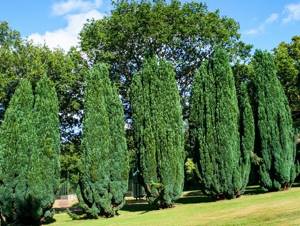
The cypress tree does not have to be specially shaped; the Elwoodi variety has a dense, beautiful cone-shaped crown.
If desired, you can give the conifer an intricate shape. It is better to cut in early spring, while the plant is dormant. No more than a third of the green mass can be removed at a time.
Pests and diseases
At home, conifers are very rarely affected by diseases. If you do not follow the watering regime, the plant is at risk of fungal infection and root rot. In the early stages, the disease is treated by transplanting the plant into new soil and treating it with a fungicide (Bordeaux mixture, “Strobe”).
In dry air conditions in a living room, spider mites and scale insects can grow on conifers. Insects are destroyed with insecticides and acaricides, air humidity is increased, and removed mechanically - washed off the branches with soapy water.
Comments (8)
Elena
07/12/2015 at 00:18 |
That year, they planted an Elwoodi cypress on their summer cottage. This is a rather whimsical plant that requires constant attention. But it's worth it. Cypress is incredibly beautiful.Answer
Yulia Expert Plodogorod
07/03/2020 at 22:16 |
Hello, Elena! You are absolutely right, in order to get a healthy and ornamental Elwoodi cypress plant, you need proper care for it. But, there are some tricks that can make this task easier and reduce the cost of time and labor.
To begin with, in order for the crop to develop well, you need to properly prepare the soil by adding peat to it. This will help both acidify the soil and make the substrate looser. If such measures were not taken during planting, you can mulch the tree trunk circle with the described element.
At the same time, it is important to choose the right type of peat. Much depends on the initial quality and acidity of this material. If the soil on the site is neutral or alkaline, you can take a little high-moor peat. It is light brown in color and contains many nutrients, including calcium.
If the soil at the site where Elwoodi cypress is planted is acidic in itself, high-moor peat in its pure form is not suitable for adding to the substrate and using as a ground cover material. Before use, you need to add lime, ash or dolomite flour to this product.
You can also use lowland peat, its Ph is closer to neutral. But it is better to add this substance to the substrate in the form of compost. Then all the useful elements will be sufficiently decomposed and will be available for use by garden crops, such as Elwoodi cypress.
Answer
Alexei
12/23/2016 at 01:52 pm |
quote: ...In its natural habitat it grows up to 70 meters, at home no more than 40 meters. Who writes this nonsense??? In the middle zone, after 30-degree frosts, the snow level freezes over! They don’t live in an apartment for long, just like the vast majority of coniferous plants.
Answer
Yulia Expert Plodogorod
08/06/2019 at 23:59 |
Hello, Alexey! Before expressing harsh judgments, we recommend that you familiarize yourself more carefully with the topic of the issue. There are many types of cypress, they all have different characteristics, including crown size and growth rate.
Dwarf or low-growing species are most often used to decorate a site, especially if the garden is not large. They look better, can complement other compositions, and can be shaped.
The pea-bearing paris can reach 25-30 meters. The homeland of this variety is Japan. Most varieties have low winter hardiness and in the conditions of the middle zone the trees can actually die.
Despite the high growth of many varieties of this species, decorative varieties are more common. Thus, the Nana variety reaches only 60-70 cm. At the same time, the average height of Boulevard is 5-5.5 m.
As for the very tall species up to 70 m, information about which has caused so much mistrust, these include Lawson cypress. But smaller specimens are often used to decorate the site. Among them, Elwoodi, which reaches 2-3 m, has bluish needles and spreading branches.
Varieties of blunted conifers are quite large. In the homeland of its growth, in Japan, this plant reaches 40-50 m and 1.5-2 m in trunk diameter.
Nootkan species are found on the Pacific coasts. Even in mid-latitudes, the Leyland variety is cultivated, with an average height of 15 m.
In this context, home conditions imply a summer cottage or garden plot, and not cultivation on a windowsill.
To prevent plants from freezing from frost in winter, you should choose appropriate cold-resistant varieties. Although, cypress trees are, in principle, considered southern crops and do not always tolerate severe frosts, even in shelter. To increase the chances, especially for young specimens, it is necessary to wrap both the crown and the rhizome.
Answer
Novel
01/03/2017 at 13:59 |
Yes, clearly 40-70 meters is not Cypress. Sites like these are scary, where they write without realizing that they are writing nonsense.
Answer
Yulia Expert Plodogorod
08/07/2019 at 21:08 |
Hello Roman. We recommend that you read the descriptions of the varieties and species of these plants on any other resources. The sizes are indicated correctly. Of course, not all varieties are characterized by such growth, but given the presence of more than 200 varieties, their characteristics vary greatly.
Most varieties of this plant grow well only in mild maritime climates, warm winters and high humidity. If these parameters are met, the tree will be able to develop fully and reach its maximum size.
As for the middle zone, especially regions with very cold winters, even cold-resistant crops suffer here. In such unsuitable conditions, southern plants cannot reach their potential, and therefore are characterized by short growth and a not very spreading crown.
In cold climates, many types of cypress can only be found in botanical gardens.
Another feature of this culture is its slow growth. This also explains the significant life expectancy. For example, Nootka cypress can live about five hundred years.
Since in unsuitable conditions cypress trees do not live as long as they could, their size is naturally less significant. This culture is suppressed due to cold and insufficiently humid air, because coastal conditions are extremely difficult to artificially create.
For these reasons, in mid-latitudes the trees described are much smaller than in their homeland. Perhaps this creates confusion when describing this culture.
Answer
Olya
08/05/2019 at 04:24 |
To be honest, at first I also thought that we would be talking about some special type of cypress. This plant is not common in our country; moreover, many people don’t even know about it. Which climate is more suitable?
Answer
Yulia Expert Plodogorod
08/07/2019 at 22:28 |
Hello, Olya! The homeland of this plant is considered to be East Asia and North America. Therefore, most varieties of cypress grow well only in mild climates. Also, high air humidity is very important for these plants, especially those varieties whose distribution aura is located near the coast.
They have low winter hardiness, with the exception of some species that try to adapt to mid-latitudes. But, they do not tolerate severe frosts, even with good shelter. In cold regions, many varieties have been adapted for cultivation as indoor crops.
But even in such conditions, the conifer can be capricious, because it needs high humidity. It is best to use a stationary humidifier so that spraying directly on the crown does not cause a fungal infection.
We would like to note that places such as Siberia, the Urals or the Moscow region are not suitable for even the hardiest varieties of this crop. The only way to cultivate the described plant in a harsh climate is to plant it in a pot.
In this case, the plant is simply taken for the winter in a cool, but not frozen room. Moreover, you need to change the place of growth in the fall so that the conifer does not have time to freeze.
You can grow cypress trees in open ground, for example, in Moldova.
Answer
Plant care rules
This shrub does not belong to the category of particularly whimsical ones. But he still needs to be provided with certain conditions for full development:
- compliance with the light regime:
- optimal temperature;
- maximum permissible humidity;
- timely watering;
- application of necessary fertilizers.
Cypress does not need light too much, but it also does not like shady areas. It begins to lose its appearance and stretches upward. The needles turn green. If we are talking about White or Gold varieties, then excess light will cause color loss. Excessive light is harmful because the leaves will burn and fall off.
To protect the plant in the winter months, it should be placed on a windowsill; a place near a window is best suited for this; there is the necessary coolness here. In spring, direct sunlight should be avoided. To do this, you need to move the cypress to a room whose windows are directed to the north. When it gets warmer, the plant is taken out to the balcony, while creating a slight darkening.
To properly grow Elwoodi cypress, planting and caring for it must be done according to the rules.
Temperature
Cypress prefers a cool atmosphere. In winter, the temperature should not rise above 15 degrees. In summer, the bush may die, as it absolutely cannot tolerate heat, so it is not recommended to take it out of the apartment. During such hours, you should use a sprayer - this will make it easier to cope with the elevated temperature.
Air humidity
Elwoodi cypress needs regular humidity control. In a dry microclimate, the needles fall off and dry out.
To avoid such problems, spray twice a day. To prevent humidity from decreasing, you can use a container of water placed under the plant pot.
When the temperature in the apartment increases, you should use snow: you need to place it near the plant; During hot periods, you should take ice from the freezer. To obtain it, just fill the molds and place them in the refrigerator. There is nothing complicated in the procedure, and it will greatly help the plant to survive. In this way, the temperature is reduced and additional humidification occurs.
It is necessary to water the plant regularly in the summer, and during cold weather it is enough to do this using melt water as the top layer of soil dries. If there is insufficient watering, the cypress dies.
For watering purposes, it is recommended to use only soft water. An excellent option would be water from a kettle, previously boiled and cooled.
Excessive watering is also undesirable, as this will negatively affect the bush. In order not to overdo it with moisture, you should purchase a dispenser. When using ice, this is not required, since the melting occurs gradually, therefore, adjustment can be made by using a certain number of cubes. This will help keep the soil moist and the temperature lower.
Fertilizer use
If you decide to plant Elwoodi cypress, care at home must be correct. To grow, it needs fertilizing. This is especially true for summer time. Mineral fertilizers would be an excellent option.
You can use different options, but, according to experts, the dosage should be reduced by exactly a couple of times.
